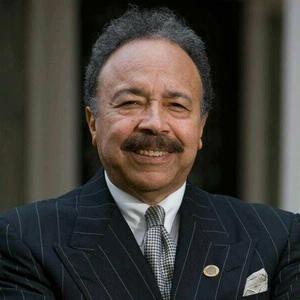In a move that could cause a cultural shift and change the balance of power in HBCU athletics, Hampton University on Thursday announced that it is leaving the MEAC to join the Big South Conference.
According to a statement released by Hampton University President Dr. William R. Harvey, Hampton sought a more proximity-friendly conference.
 Dr. William R. Harvey
Dr. William R. Harvey“Our student-athletes will spend less time traveling and more time in classes on campus,” Harvey said. “This keeps the proper focus on academics, which is our chief reason for being. The smaller geographic footprint will also reduce travel expenses.”
Most of the MEAC schools are located in North Carolina, Delaware, Maryland, Virginia and Washington — with two in faraway Florida (Florida A&M and Bethune-Cookman). However, the entire Big South Conference for most sports is based in Virginia, North Carolina, and South Carolina, obviously much more geographically friendly for Hampton, which is celebrating its 150th anniversary this year.
Hampton, which was a member of the MEAC for 22 years, officially will join the Big South on July 1, 2018. Sixteen of the 17 Hampton sports will be played in the Big South Conference, with men’s lacrosse the only exception.
Author, HBCU historian and college administrator Michael Hurd is director of Prairie View A&M University’s Texas Institute for the Preservation of History and Culture. He is also the author of Black College Football: 1892-1992 — One Hundred Years of History, Education, and Pride.
“It’s sad to see another program leave a traditional HBCU conference, but I understand the cost-cutting, fiscal reasons — reducing travel costs, and academic reasons as well, such as less time away from the classroom,” said Hurd in an interview with Diverse. “Hampton has been a vital member and a force in the MEAC throughout its affiliation with the conference. You’re already seeing HBCUs as system members of state universities, and that presents the challenge of maintaining the sense of Black culture.”
Big South Conference Commissioner Kyle Kallander welcomed Hampton and praised the university’s academic and athletics accomplishments.
“We have always been impressed by Hampton’s academics and athletics accomplishments under President Harvey’s visionary leadership,” Kallander said. “We appreciate his interest and support of the Big South and look forward to working with him and the rest of Hampton’s leadership to support our student-athletes. The Big South is a better conference with Hampton — athletically, academically, and in providing outstanding opportunities for our student-athletes.”
The Big South is comprised of 10 holdover schools in most sports located in the Virginia-North Carolina-South Carolina trio; the additions of USC Upstate and Hampton this week make 12. However, only four of those holdover schools play football, along with football-only Kennesaw State University in north Georgia and Monmouth University in central New Jersey. North Alabama’s football program will join the Big South in 2019, along with Hampton in 2018.
When schools change conferences, the reasons usually center around four issues: money, television packages, expansion of the campus profile/brand and national exposure for recruiting, said Dr. Allen R. Sanderson, professor of sports economics at the University of Chicago.
“The broader issue of realignment is that there has been a common denominator in recent years and that is money,” Sanderson said. “The number of teams also is an issue. What it does is allow you to play a football conference championship game. Conferences also are re-aligning and expanding mainly for the television markets.”
The Big South doesn’t have a conference championship game — not yet, anyway.
“There have been rumors the past few years that Hampton has been looking to join the Big South,” sports columnist Harry Minium of the The Virginian-Pilot in Norfolk told Diverse,
According to the Virginian-Pilot, the MEAC has ranked 31st or 32nd in the 32 Division I men’s basketball conferences the past few years; in football, the MEAC has ranked 20th on the Division I level, with the Big South at No. 15.
Hampton University athletic director Eugene Marshall Jr. told The Virginian-Pilot that it will maintain its roots, but it was time to move forward to attain its goals. “Hampton University is always going to be an HBCU,” Marshall told the newspaper. “That’s not going to change. We’re not (going to stop) competing against our fellow MEAC schools.
“But as we look at the bigger picture, of trying to build the best mid-sized athletic program in the country, you have to take steps. We’re not leaving. We’re just expanding our reach.”
The loss of Hampton most assuredly will affect the dynamics in the athletics hierarchy of the MEAC, which includes such schools as Howard University (Hampton’s chief rival), North Carolina A&T and Delaware State. Hampton is a huge draw in both men’s and women’s basketball (especially the MEAC tournaments held in the Norfolk area), as well as football.
Hampton also has sent players to the NFL, including Chris Baker, a defensive tackle currently with the Tampa Bay Buccaneers and Reggie Doss, who played for the Los Angeles Rams from 1978 to 1987.
In basketball, former NBA tough guy Rick Mahorn played at Hampton; he’s most known for his career with the “Bad Boys” of the Detroit Pistons in the 1980s.
Hampton is one of the few predominantly Black colleges to join a conference of predominantly White institutions. Tennessee State, another HBCU, joined the Ohio Valley Conference, comprised of PWIs, in 1986.
HBCU author-historian Hurd said, “I’m hoping, as Tennessee State has done, the Hampton Pirates will continue to include Black college rivalries as part of their non-conference schedules to keep those traditions and Black college football history alive.”





















